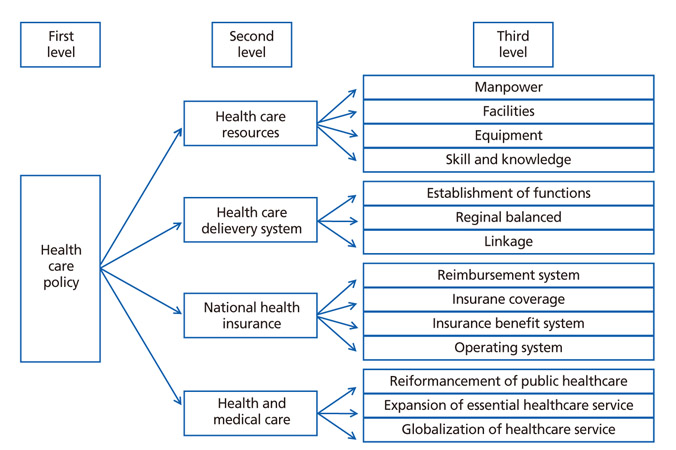J Korean Med Assoc.
2017 Feb;60(2):164-172. 10.5124/jkma.2017.60.2.164.
Priority analysis of the healthcare policy using analytic hierarchy process
- Affiliations
-
- 1Research Institute for Healthcare Policy, Korean Medical Association, Seoul, Korea. playbwv@gmail.com
- 2Department of Biostatistics, Korea University College of Medicine, Seoul, Korea.
- KMID: 2368927
- DOI: http://doi.org/10.5124/jkma.2017.60.2.164
Abstract
- The purpose of this study was to suggest signposting strategy for healthcare policy. Analytic hierarchy process analysis was used to classify the decision levels of healthcare policies using the Delphi professional survey and a literature review. National health insurance was identified as a priority healthcare policy. After that, arranged in order of priority, were the healthcare delivery system, health and medical care, and healthcare resources. Among the sub-levels in healthcare policy, the reimbursement system was a priority policy. This study confirmed that healthcare providers are interested in national health insurance. because their greatest concern was the reimbursement system. Consequently, in order to determine and implement healthcare policy efficiently, the government should consider the opinions of healthcare providers.
Keyword
MeSH Terms
Figure
Reference
-
1. Statistics Korea. Estimated future population [Internet]. Daejeon: Statistics Korea;2012. cited 2016 Mar 2. Available from: http://kosis.kr/statHtml/statHtml.do?orgId=101&tblId=DT_1B35001&vw_cd=MT_ZTITLE&list_id=A41_10_10&scrId=&seqNo=&lang_mode=ko&obj_var_id=&itm_id=&conn_path=E1&path.2. Peoplepower21. 2016 Draft budget analysis of Ministry of Health and Welfare [Internet]. Seoul: Peoplepower21;2015. cited 2016 Mar 4. Available from: http://www.peoplepower21.org/index.php?mid=PSPD_press&category=1041678&document_srl=1366284&listStyle=list.3. Ministry of Health and Welfare. 2016 New policy [Internet]. Sejong: Ministry of Health and Welfare;2016. cited 2016 Mar 4. Available from: http://www.mohw.go.kr/front_new/policy/sotong/2016/index.jsp?PAR_MENU_ID=06&MENU_ID=06490201.4. Park YO, Son CH. Prioritization in the policy of integrated medicine that uses the Delphi method and analytic hierarchy process. J Physiol Pathol Korean Med. 2015; 29:66–71.
Article5. Jillson IA. Developing guidelines for the Delphi method. Technol Forecast Soc. 1975; 7:221–222.
Article6. Kim SY, Park BJ, H DS, An HS, Lee SM, Youn HY, Shin SS, Han SK, Bae EY, Park DA. Evidence-based healthcare. Seoul: Korea Medical Book Publisher;2009.7. Lee KS. Healthcare policy: new paradigm. Seoul: Gyechuk Munwhasa;2016.8. Lee JS. The direction of reform for health care delivery system. J Korean Med Assoc. 2016; 59:248–250.
Article9. Kang KU, Nam YH, Park KR, Park JW, Park YH, Oh HS, You JY. Comprehensive health insurance. Paju: Gigu Publishing;2015.10. Kim CY. Theories of health security. Seoul: Hanul;2016.11. Huh SL. Policy issues on the limited coverage of the national health insurance. Health Welf Policy Forum. 2008; 140:22–38.12. Lee JJ. Survey of R&D investment portfolio composition [Internet]. Seoul: Korea Institute of S&T Evaluation and Planning;2006. cited 2016 Dec 22. Available from: http://www.kistep.re.kr/c3/sub2_3.jsp.13. Lee CH. Group decision making. Seoul: Sejongbooks;2000.14. Lee JE, Yu HJ, An CH, Jung BY. Analyzing the Relative Importance of the National Crisis and Emergency Management Policy Areas: Measuring the Priority Using Analytic Hierarchy Process. MSPA. 2007; 12:277–299.
- Full Text Links
- Actions
-
Cited
- CITED
-
- Close
- Share
- Similar articles
-
- Development of Agenda Priority for Nursing Service Research and Development
- Priority survey between indicators and analytic hierarchy process analysis for green chemistry technology assessment
- Setting Priority Criteria for Classification of Self-Testing In Vitro Diagnostic Medical Devices Using Analytic Hierarchy Process Technique
- A Research on Local Community’s Acceptance and Human Factors Using Analytic Hierarchy Process
- Presidential Election and Health Policy


